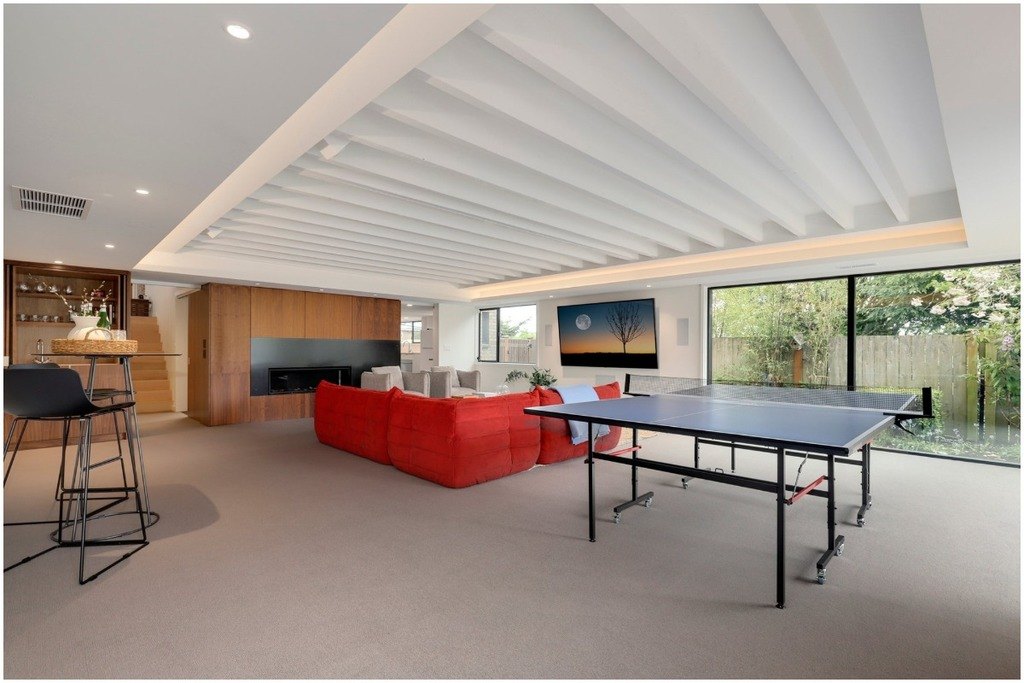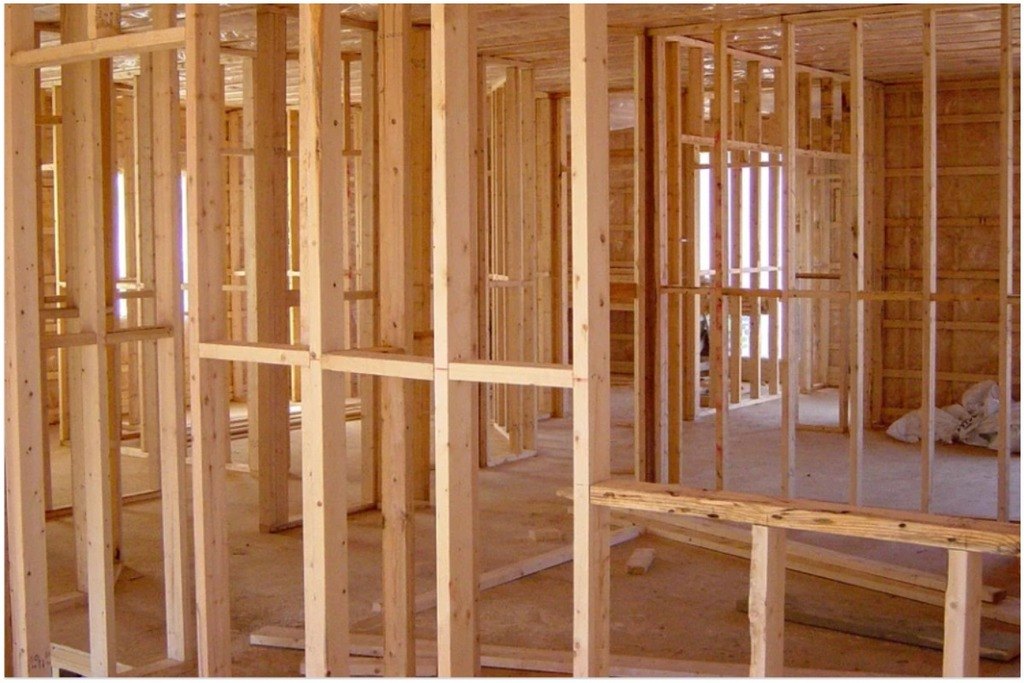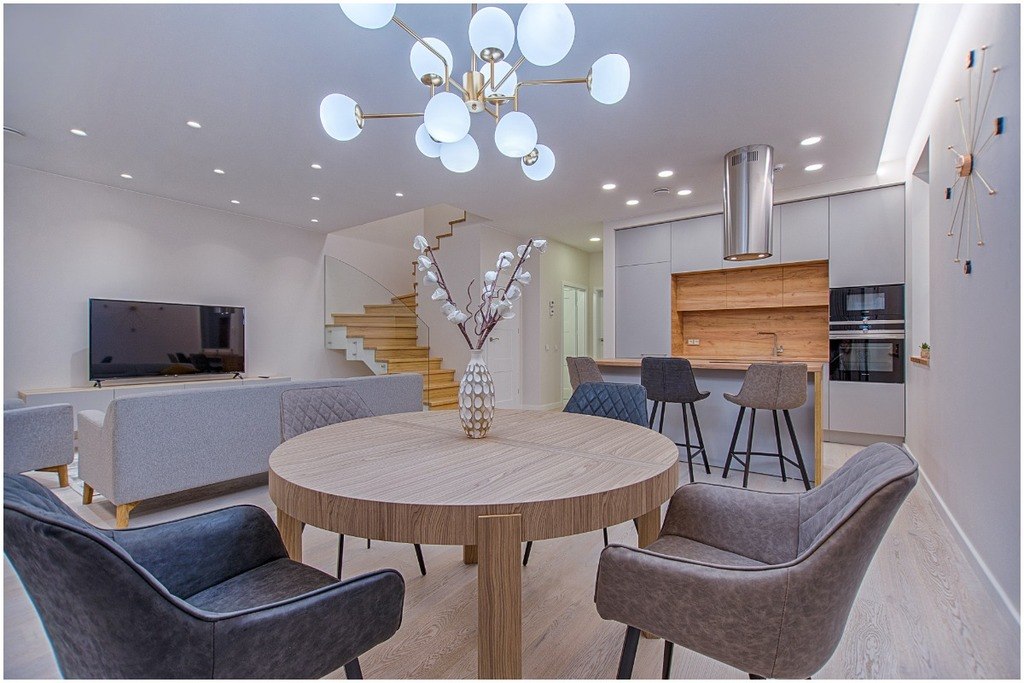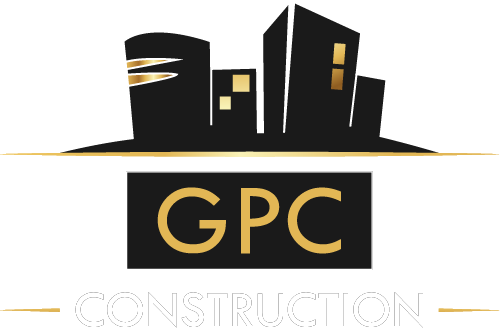Go Pro Construction was excited to be featured and quoted in Redfin’s latest blog—Basement Remodeling: How Much Does It Cost? Please check it out, along with Go Pro’s other blogs on how to plan your own basement remodeling project.
Picture your unfinished basement -a cold, dark, uninviting space that you have been wanting to finish for years. An unfinished basement is the perfect blank slate to design a space that fits your needs. You can create an extra bedroom, the ideal area for entertaining, or even a personal yoga studio. A finished basement can be a major asset when it comes time to sell and can even add to the total square footage of your home. But how much does it cost to finish a basement? Let’s take a closer look.

How much does it cost to finish a basement?
The cost to finish a basement will vary greatly depending on your location, current state of your basement, type of materials,and any extra features you want to incorporate like a bathroom, bedroom, or movie room. On average, homeowners spend anywhere from $22-$50+ per square foot when finishing their basement. If you’re planning on finishing your basement, you should plan on spending about $20,000 -$45,000.
Keep in mind that this is just the average cost. If you’re looking to add several specialty rooms, buy high-end flooring and fixtures, or if you have a very large basement, you could end up spending $100,000 or more. With such a large variation in how much it costs to finish a basement, you may be wondering how you can afford it and make sure you stay within your budget. Here’s a breakdown of the main costs you can expect and other optional costs.
Basement finishing cost breakdown
| Main Costs | Average price range |
| Labor | $25-$100 per hour |
| Framing | $7-$16 per linear foot |
| Finishing walls and ceiling (includes drywall, insulation, and paint) | $4.80-$8 per square foot |
| Water sealant | $2-$10 per square foot |
| Flooring (includes subfloor and flooring) | $1-$20 per square foot |
| Electric | $500-$3,000 |
| Furniture | $200-$5,000 |
Hiring labor or a basement contractor
Hiring a trusted and high-quality basement contractor will likely be one of your biggest costs. You could spend anywhere from $25-$100 per hour for labor. The price of a contractor will vary based on your location and the scope of your project. For example, a quote from a contractor in New York, NY is likely very different from one in Omaha, NE.
A common rule of thumb is to portion off about 20-35% of your budget for labor. To get an accurate estimate, it’s best to reach out to a contractor and get a personalized quote. Make sure to check to see how they charge, some include the price of their labor in the project while others charge hourly.
When hiring a basement contractor, Go Pro Construction advises people to “thoroughly research and interview your general contractor. They should treat you like a partner throughout the process, by not only providing you with an all-inclusive budget upfront, but also discussing options with you at every stage of the project. Unforeseen obstacles can always come up, so make sure to also discuss how much of your budget is set aside for contingencies. Open communication will keep the project moving forward on time and on budget, keep stress levels down, and will result in a project you’ll love.”
Basement framing
Lumber prices have recently skyrocketed making basement framing more expensive than it’s been in the past. The estimated cost to frame a basement is about $7-$16 per linear foot. This includes the cost of lumber and other small materials like nails and studs. This number will increase if you plan on framing basement walls with steel instead of wood, or if you’re creating a load-bearing wall.

Finishing basement walls and ceiling
After framing, you’ll need to finish your basement walls by installing drywall and insulation and adding a coat of paint. The average basement drywall cost is about $2 per square foot while insulation is around $0.80-$2 per square foot. The cost of paint will vary, but expect to spend anywhere from $2-$4 per square foot. Keep in mind that you’ll likely have to include the square footage of the ceiling into the total square footage of your basement remodeling project.
Waterproofing
If you’re starting your remodel with concrete flooring, you’ll need to waterproof your basement to keep out moisture and protect it from flooding. Waterproofing will “prevent future flooding and helps protect your investment. One of the first steps in any basement remodeling project is to contact a qualified waterproofing contractor. They will provide you with an accurate assessment of how to avoid basement floods in your home.” – 20,000 Leaks
To waterproof your basement, your basement contractor will fill any cracks or holes in the foundation and then put down a water sealant. A water sealant is typically about $2-$10 per square foot and it’ll protect your basement flooring from accumulating moisture from underneath.
Basement flooring
A contractor will likely need to install a subfloor before any flooring is added. The material cost for subfloors is about $2-$7 per square foot and it’ll help insulate the basement. Flooring prices depend on the type of flooring you want. Some homeowners choose carpet since basement floors can get pretty cold, while others choose a water-resistant floor like tile or engineered hardwood. Depending on which flooring you pick, you could spend as little as $1 per square foot for vinyl or ceramic tile, or as much as $25 per square foot or more for high-end wood flooring.
No matter what flooring you choose, it is crucial to keep your basement dry. EquipSupply wants to remind homeowners that “having a dehumidifier is a great idea for keeping condensation out of your basement. This will help prevent mold from forming and preserve your remodel. If you have carpet in your basement, this is especially important.”
Lighting and electric
Some unfinished basements already have lighting or electrical lines installed. However, there are typically only a few light bulbs or outlets. It’s best to have your contractor or electrician install adequate lighting to your finished basement. Adding lighting and electric outlets can cost you anywhere from $500-$3,000 depending on the current electrical lines and size of your basement.

Furniture and decor
The final step when finishing a basement is to add decor and furniture. The cost of furniture and decor can add up quickly so be sure to allocate money in your budget for it so you can start enjoying your basement as soon as construction is over.
Optional basement remodeling costs
Some homeowners may want to add a bathroom or bedroom when finishing their basement. Here is a price breakdown of some common features you can include in your basement remodel.
Basement bedroom
Adding rooms will increase your basement remodeling cost since you’ll need to pay for the additional framing, drywall, insulation, paint, etc. Keep in mind, if you add a bedroom you’ll not only have to pay to build that room, but you’ll need to pay for electrical outlets, a closet, extra doors, furniture, and a window to comply with safety regulations. In short, the more rooms you add, the higher your basement remodel costs will be.
Chris Campbell, a fire protection engineer, wants homeowners to remember that “if your finished basement will include a bedroom, it’s important to be aware of certain code requirements that apply to sleeping areas. For example, the International Residential Code requires basement sleeping rooms to have at least one operable emergency escape and rescue opening to allow someone to escape during an emergency. Many state and local governments also have their own requirements, so be sure to check the applicable building or residential code for your area.” – The Building Code Blog
Sump pump
Though optional, a sump pump is something that can save you thousands of dollars down the road. If your basement floods, a sump pump will drain away any water that accumulates on the basement floor. A sump pump plus installation can cost anywhere from $600-$1,500 and should be installed at the lowest point of your basement. Installing a sump pump is especially important for homeowners living in areas with a high risk of flooding. Many insurance companies will actually require a sump pump to be installed before the home can be eligible for flood insurance.
There are many ways to incorporate a sump pump into your basement finishing plans without it being an eyesore. Talk to your contractor about ways to add a discrete sump pump into your basement remodel.
Heating and air conditioning
To keep your basement comfortable year-round, the space will need to be properly set up with adequate heating and cooling. Have your contractor look at your existing HVAC system to see if it’s large enough to handle the heating and cooling needs of your newly finished basement. If it’s too small or outdated to handle the extra square footage, you’ll need to purchase a new HVAC system and pay for new ductwork.
You can expect to spend between $4,000-$10,000+ for a new system and ductwork needed to heat and cool your basement. Also, be aware that adding new space to your HVAC system will increase your monthly electric bill.
Building permits
Since finishing a basement is a large renovation project, you’ll most likely need a building permit to proceed with your basement remodel. In most cases, your basement contractor will obtain the building permit since they are responsible for ensuring the project is up to code. The permit can cost anywhere from $50-$2,000 depending on the size of your project and your state.
Foundation inspection
“Whether you’re spending $15,000 or $100,000 to finish your basement, have your foundation inspected for potential problems such as foundation cracks, abnormal foundational movement, or loud/slow draining sump pumps. Hire a foundation expert who will consult with you and give you honest, pressure-free advice about how to handle any foundation issues – it only costs a few hundred dollars and it’ll protect your newly finished basement from any unplanned problems.” – H&N Basement Worx
A foundation inspection can also help you identify the best waterproofing methods for your home. “There are 3 types of waterproofing methods: barrier protection, structural integral protection, and drained protection. Each method has its own set of advantages and disadvantages, so it’s important to contact a fully qualified waterproofing contractor to carry out an inspection and identify which waterproofing solution should be used. However, water ingress isn’t your only problem. You need to keep your basement well ventilated, otherwise, any water that makes its way into your basement can easily turn into condensation and cause nasty problems like black mold.” – Timberwise
Adding a bathroom or specialty spaces
If you have a large budget, you may want to take your basement to the next level by adding a bathroom or a specialty space. The cost to add a bathroom to your basement can be anywhere from $7,000-$20,000 depending on if your basement already has plumbing and the size of the bathroom. A small 5×7 bathroom will be much more affordable compared to a bathroom with a larger layout.
Creating specialty rooms like a home gym, wine cellar, or movie theater is a great way to personalize your home and make it your own. There’s really no limit to how much these specialty rooms can cost, so reach out to your contractor to get an accurate estimate of the potential cost.
How to save money during your basement remodel
Finishing your basement can get expensive, fast. Here are some easy ways to save money on your basement remodeling project while still creating the basement of your dreams.
- DIY where you can: Save money by completing simple basement remodeling tasks yourself. Some easy ways to get involved and save money are to help install flooring, paint walls, or install fixtures.
- Save on materials: The most expensive option isn’t always the best. Do your research and find flooring and light fixtures that are high-quality and budget-friendly.
- Reuse/thrift furniture: If you find yourself getting close to the top of your budget, consider saving money on furniture. You can find local, inexpensive furniture on web-based marketplaces, thrift stores, or by asking your friends and family if they have any furniture that you could take off their hands.
- Open floor plan: By choosing an open floor plan for your basement you could save hundreds on lumber, insulation, and drywall.

Steps to finishing a basement
Now that you know how much it costs to finish a basement, you may be wondering how to get started on your own basement remodel. Here are the first 4 steps to finishing a basement.
- Calculate your budget: The first thing you need to do – and probably the most important – is determine your budget. This will give you a realistic sense of what kind of layout, flooring, and level of labor you can afford for your basement remodel.
- Figure out the purpose of the space: You want to make sure your basement will fit your needs. For example, if the finished basement will be used as a mother-in-law suite then you’ll need to make a separate bedroom and bathroom. However, if the space will be used as a playroom for kids, then an open floor plan would be more ideal.
- Contact basement contractors: Reach out to several contractors that have experience remodeling basements with similar features to yours and receive personalized quotes. Pick one with the best price and experience for your needs and they’ll work with you to create a personalized remodeling plan. “Choosing the right contractor to tackle a remodel is one of the most important decisions a homeowner can make. Select one that’s reputable, professional, does quality work with skilled, licensed craftsmen, and sets expectations appropriately upfront in regard to pricing and timing.” – Ascent Builders
- Check to see if your property is in a flood or fire hazard zone: Leila Banijamali, Co-Founder and CEO of Symbium advises homeowners, “whether or not your property is in a flood zone or another environmentally hazardous area may impact your decision on how to remodel your basement and if a remodel is possible. One way to find this information is by entering your address on our website where you will get instant insight into environmental hazards and concerns. A property that’s located within a flood zone may require additional waterproofing, grading, or drainage, while a property in a fire hazard zone may need additional fire safety planning, such as removal of trees overhanging the structure, creation of defensible space, or the addition of fire-retardant materials.”
Be mindful that your basement remodel may take several months to complete from start to finish. “Remodeling projects are notorious for running over schedule. The project can be delayed by uncontrollable circumstances like bad weather, the discovery of asbestos, materials on backorder, difficult plumbing, foundation cracks, etc. All homes hold secrets in the walls and under the floors and demolition will bring those to light. Be mentally prepared for potential problems so that when they arise, you and your contractor can quickly come up with options on how to proceed.” – Collaborative Construction
Does a finished basement add value to your home?
If you’re wondering if finishing your basement will be a good investment and increase your home’s value, the simple answer is – most likely.
A basement that includes an additional bedroom, bathroom, or kitchen, will likely significantly increase a home’s value. If you’re thinking about creating a completely separate space in your basement, Volcano Builders suggests that you consider utilizing your basement as an additional dwelling unit (ADU). “ADUs can add a lot of value by providing rental opportunities, equity gain, and adding to the potential resale price of your home. While ADUs have many benefits, keep in mind that they often require more time and money than a standard remodel. For example, a basement ADU needs a direct drain line to the city sewer and a separate water meter from the main residence which adds additional demolition, preparation, construction, and installation labor costs.”
However, even if your finished basement primarily functions as an extra living room, the additional living space will likely be a feature that potential homebuyers will find desirable. Make sure to take a look at similar homes for sale in your area to see if other homes have finished basements. If they don’t, then finishing your basement may help your home stand out amongst the rest.
*Individual results may vary. This is not intended as a substitute for the services of a licensed and bonded home services professional.
Originally published on Redfin.com


